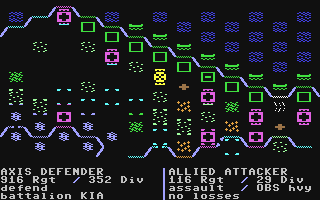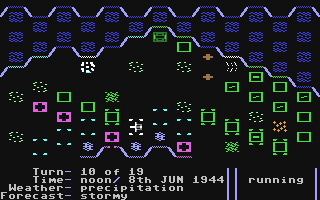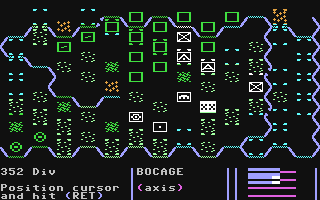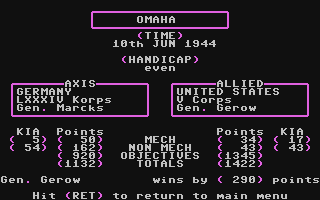|
THAT'S
ENTERTAINMENT?
For
the first time, Manoeuvres comes to you directly from
the keyboard of an Amstrad PC. Some friends and I (including
John Woods who writes for THE GAMES MACHINE) are starting
a PBM company and have invested in this computer to
use as a word processor for our first release, a role-playing
game called Revenge of the many-legged Man Eating
Mutant Tiger Hounds from Outer Space. I'm largely
responsible for the conception and design of this masterpiece,
and I'll be moderating it.
One
of the things that we've all discovered while attempting
to describe our new enterprise to friends, relatives,
landlords and accountants, is the near impossibility
of communicating the concept to those who have never
heard of play-by-mail games or role-playing. The last
line of the conversation is usually a bewildered, 'And
they PAY you for this?'
I
should imagine that most readers of Manoeuvres have
experienced a similar sort of difficulty in trying to
make the uninitiated understand the value of entertainment
software. When I tell someone that I make a living writing
for a computer games magazine, and even go into some
detail about what it is I actually do, I feel certain
that days or weeks later the same person, on meeting
a computer boffin, seeing an item on 'Tomorrows World'
or coming across an IBM at work, will say, 'It meant
nothing to me, but of course you know all about computers,
so I thought you could explain it.' It's hopeless to
protest that my Spectrum Basic is limited to LOAD ""
and Commodore Basic to LOAD"*",8,1; even if they begin
to grasp that really, honestly, all I ever do is play
games, the reaction is likely to be hostile.
For
a start, many peoples' experience of computer games
is limited to, and coloured by the arcade machine blasting
away in the corner of the pub, and a folk memory of
Space Invaders. Therefore it's difficult to convince
someone who has never seen a modem home computer that
many are more refined than the conversation-interrupting
monstrosity next to the only free table. It's almost
impossible to make them believe that one can get the
same degree of intellectual challenge and satisfaction
from a strategy or adventure game as one can from a
crossword or traditional board game, and that such games
can be every bit as worthwhile and 'wholesome'.
This
frustrates me sometimes, particularly as I know that
there's a respect in which computer games can be unwholesome.
I wrote about it a couple of months ago: the addictive
effect the best and worst of them can have on the player's
mind.
Another
'syndrome of misunderstanding' is the 'use of a home
computer' fallacy. It's been sufficiently stated elsewhere
before now that a home computer has no use except as
a flexible games machine -- for a home computer like
the Commodore, anyway. Anyone who has any personal contact
with the facts of the matter knows that the one-time
ideas, which are still current in uninformed minds,
about using a home computer to regulate the central
heating or store addresses are nonsensical. The Commodore
doesn't even make a particularly effective word processor.
Those
of us who are interested in strategy games ought to
make an attempt to convince others of their value. The
less misunderstanding there is, the more people are
likely to try these games, enjoy them and buy them.
.
|
|
Last
month I reviewed SSG's Russia. Their latest release,
Battles In Normandy is in outward appearance
a similar production. Having grappled with the meaty
orders system of the former game, and more or less got
to grips with the branching menus, I expected familiarising
myself with Battle In Normandy would be less
work. However, although the general presentation is
much the same, and the on-screen appearance and packaging
identical, there are many subtle and not-so-subtle differences
that make Battles In Normandy far different from
Russia.
The
game comes in the same type of substantial fold-open
card wallet as Russia, with an 80-page rulebook,
reference cards printed with diagrams of the branching
menus that run the proceedings, a. glossy full-colour
map and that thoughtful touch, a strip of labels for
your save game disks. I have to make a special mention
of the map, because -- with the somewhat irrelevant
exception of the little toolkit I got in the packaging
of Autoduel -- it is probably the best quality component
extra I've seen in a wargame. It shows Normandy, simplified
into small hexes of many different types of terrain,
and having diagrammatic boxes enclosing the areas in
play on the screen for each scenario.

In
a connected series of eight scenarios -- for some reason
there isn't a grand campaign game -- Battles in Normandy
recreates the British invasion of Normandy and the battles
that were fought around the beachheads they created.
The historical analysis in the rulebook describes this
campaign, from the Allies' point of view, as a 'strategic
success and a tactical failure' rather than the unqualified
triumph of popular conception. Recreating the actual
situation is of very great importance in this game --
it comes closer to being a simulation of history than
most computer wargames even attempt -- and this explains
the complexity and the vagueness of its victory conditions.
Because the Allied invasion of Normandy was a success,
a player who chooses to land himself with the Axis powers
in any scenario is likely to fail in an overall sense.
Victories are won and lost on points rather than the
achievement of specific goals, and points are won by
capturing and hanging onto 'objectives'. Capturing the
objectives is not as important as retaining them, for
each give points per turn. Some aren't valuable for
the whole length of the scenario and only give points
between specified turns. This system of rewards manages
to create an atmosphere of frantic ground-grabbing --
the player is advised to catch and keep every objective
in sight -- and it gives each scenario more flexibility
than rigid conditions would.

The
player can either choose sides, or set the computer
against itself in 'observe' mode. Handicaps can be set
either way, and act as a multiplier on victory points
rather than the deployment strength or artificial intelligence
routine. After these brief preliminaries, the player
is free to wade through the apparently interminable
tangle of menus in an attempt to make sense of the system.
There
is a rather desperate sounding assurance in the manual
that it all becomes perfectly simple in the end -- this
is true. The menus become lightning fast to manipulate,
but you do have to put in quite a bit of careful studying
of their function. I'm not sure that the 'tutorial'
scenario is a great deal of help. It takes the bewildered
beginner carefully step-by-step through 'Sword', one
of the simple scenarios, but only tells one what buttons
to press, rather than why. Since the rulebook is in
a format virtually identical to Russia's, I knew
there was a detailed and comprehensive breakdown of
the function of each menu in the next chapter, and I
found myself continually referring forward to that as
the tutorial brought me up against a new menu without
explaining it.

There
are sixteen different kinds of battalions, although
they're not all necessarily available in a single scenario.
The player is conceived as operating from a fairly lofty
position in the chain of command, and controls a regiment
rather than a battalion. Regiments are made up of battalions,
appearing on the map and in reports as individual units,
but the player doesn't have the power to specify in
which hex each ends up. Orders are given to the regiment,
and the battalions attempt to follow them as best they
can.
Each
day is divided into four turns -- AM, noon, PM and nite
(sic) -- so the timescale is quite a small one.
During night turns you're not really supposed to wake
your men up and force them to do things unless there's
a pressing reason for it, so the action menus available
for these turns are structured differently from the
daytime turns to provide some degree of protection against
inadvertently depriving the troops of sleep. This adds
a feeling of shading and reality to the inevitably artificial
turn system, and drama too -- the 'Sword' scenario opens
in the middle of the night, after the 6th airborne division
has just landed on the beach and is planning to attack
the Merville battery at 2.00 am.

The
regimental orders given depend very much on the position
the regiment happens to be in. Its combat state is either
'ready', 'contact' or 'engaged' which is a general description
of how close it is to the enemy. In a merely 'ready'
state, before it has had sight of the enemy, it can
be told to rest (to recover fatigue points), move forward
to one of the objective hexes, seek a particular enemy
battalion or deploy itself defensively around its current
position. When in 'contact', after the enemy has been
spotted but before it is very close, the regiment can
choose from two severities of defensive action or launch
a limited 'probe' attack on the nearest battalion. When
'engaged', a battalion is practically on top of the
enemy, and attacks in three different ways or prepares
itself for a really effective assault in the next turn.
The sophistication is apparent, and the player has no
control over what sort of combat state any battalion
is in. The uncertainty of a real campaign, when events
take on a life of their own and the leaders do not have
the simplified God-like control of a wargamer, is suggested.
All
orders can be manipulated until the player selects Run
5, which processes the turn. One distinct irritation
about the presentation of Battles In Normandy
is the lack of any description of orders given to regiments.
It's easy to forget when you are controlling a large
number what you told each to do, and indeed if you remembered
to hand out orders to everyone.

Like
Russia, Battles In Normandy offers a comprehensive
design program as a major feature. Creating an entirely
new scenario is a big project, but there are suggestions
for minor, historically plausible variations to introduce
into each pre-designed scenario. The adventurous can
draw an entirely new map using the building blocks of
the 16 terrain hexes, and the details of forces and
deployment can be varied to an infinite degree. Conceivably,
one could concoct a very strange and unrealistic situation,
but serious users are more likely to want to type in
the scenarios printed in the company's magazine Run
5.
|